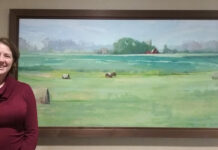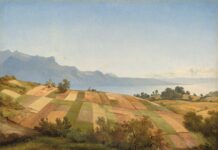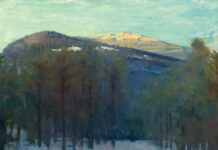
Idle in winter? That would mean being idle for nearly half the year in Wisconsin. Pamela Ruschman has other ideas, and a prejudice against a certain color.

Ruschman’s setup for “January 18 Lakescape.”
“I paint more in the winter than I do in the summer,” says the Mequon, Wisconsin, artist. “I love winter. I don’t respond too well to the humidity in the summer— I find it exhausting. In the summer I’m busy with kids. And I’m not a big fan of green.”

“January 18 Lakescape II,” by Pamela Ruschman, 2015, oil, 6 x 8 in.
What’s that? “I don’t have green anywhere in my home,” she says. “Not even in my wardrobe, other than Green Bay Packers items. I love the subtle color of winter.”

“First Taste of Winter,” by Pamela Ruschman, oil, 10 x 8 in.

“Snowflakes for Supper,” by Pamela Ruschman, oil, 10 x 12 in.
Ruschman explains that it would feel wrong to her if she didn’t “embrace and honor” winter. “I don’t even care how painting winter scenes reflects on sales,” says the artist. “People have had a good response to them, but I don’t do it for that. I do them because this is where we live and I want to embrace that. We live here, and this is our reality; I just want to document everyday life honestly.”

Ruschman’s very cold-looking setup on January 18
She says she likes how the orange sunsets of winter contrast against the gray-white snow. That kind of scene can only be done from life. Ruschman bundles up and goes out for plein air painting in winter, but she does work on studio pieces in winter as well. One theme that runs through her winter studio pieces is animals — animals clustered together for warmth, sheep in a snowstorm, cows in a barn. “Just as for humans, winter is a fact of life for animals living in Wisconsin’s frozen tundra,” she says. “I am especially passionate about the animals and the subtle nuances of winter colors around them. In winter, the warm hues of the livestock are offset so nicely by the gray/cool backgrounds, especially during a snowfall. The livestock have a beautiful thick winter coat, and I especially love it when a little snow lands on their fur or fleece. It’s such a stark contrast to summer paintings.”

On location on January 11
The winter plein air work she puts in is crucial for these indoor works. “I think my winter plein air work is the only way I could accomplish those studio pieces,” says Ruschman. “That time outside is crucial to understand the subtleties of the gray in winter. All the colors of other seasons are still there, they are just more quiet in winter. The same values in the plein air pieces are in those animal paintings.”

“Winter Path,” by Pamela Ruschman, oil, 8 x 6 in.
Several of her animal paintings show the creatures standing in falling snow. Achieving the look of falling snowflakes is a nerve-wracking process. “I thin down titanium white — and a tiny bit of cadmium yellow for warmth — with clean Gamsol and flick it on the canvas with a big hog-bristle brush,” explains Ruschman. “I recommend experimenting first on a few old canvases — nothing like spending hours or days on a painting and having it ruined by snowflakes. This part of the process is truly angst-filled.”

“January 21 Lakescape,” by Pamela Ruschman, 2015, oil, 8 x 10 in.
In talking with Ruschman, it’s clear she not only has a pragmatic respect for winter, but some affection, and a bit of loyalty to it as well. “Winter is my quiet season,” says the artist. “Winter fits my personality. It’s quiet, letting the earth rest. The only time I paint winter is in the winter. It would feel very false to me if I painted winter in summer.”




